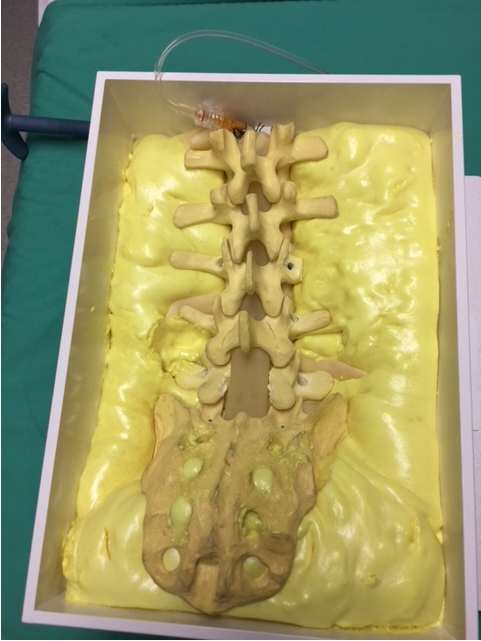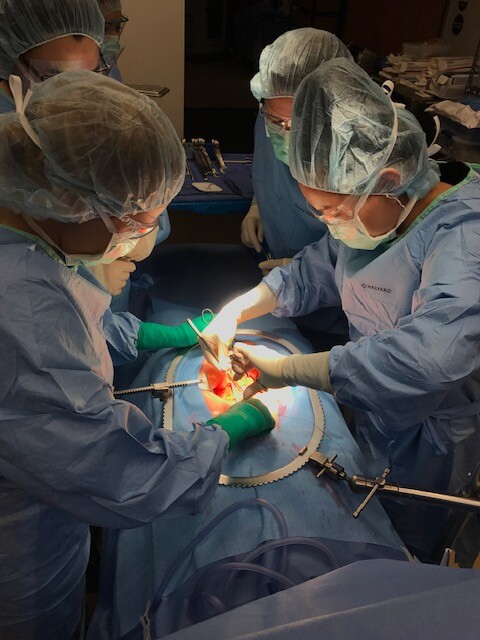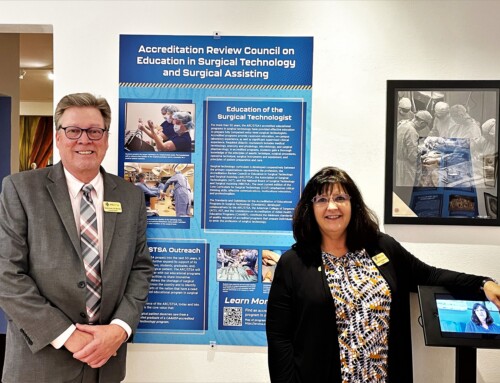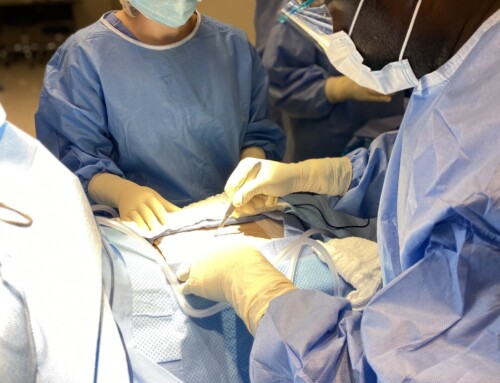By Logan Threet, AAS, CST
As educators, we bring a lot of creativity to our training, coming up with hacks, tips and tricks to demonstrate surgical procedural skills. We also know that hands-on, simulation-based training is one of the best ways to engage students and prepare them for entering the field. As program director, I look for simulation tools and training platforms that give me room to be creative.
For example, by combining a few basic supplies with our SimuLab Surgical Abdomen trainer, my faculty and I have developed a cost-effective way to simulate a wide range of surgical specialties, from general surgery to ortho/neuro spine surgery. We lay vessel loops out on an Ioban™ (an antimicrobial incise drape), then cover them with another Ioban to mimic the omentum and its vascular structures. We can insert this into the Surgical Abdomen and practice the age-old skills of “clamp, clamp, cut, cut, tie, tie.”
We have also used some of the trainers to build a spine model, incorporating expandable spray foam from the hardware store (pictured below). When paired with molding and window shims, the spray props up the spine so students have a reference of the spinus process. I like to use a Penrose drain as a dura, too, then glue and fill it with water so we can run through a laminectomy and a dural tear.
These are just a few examples of DIYs that cost the program less than $15 to make and utilize in SimuLab’s platforms. These simulations offer a cost-effective way to provide students valuable opportunities to practice and gain experience with the instrumentation and processes that are critical once they hit the clinical phase.

Pictured above is a DIY spine model, created from a trainer and expandable spray foam from the hardware store.

Surgical technology students at Wichita State University Campus of Applied Sciences and Technology (WSU Tech) practice skills using their simulation trainer.
Simulation in Action: Teaching Critical Skills
The ability to have creative freedom in teaching with these trainers has been immensely beneficial. Most importantly, though, our trainers allow us to teach the most basic surgical soft skills and progress to the most advanced surgical cases. Using a variety of trainers, my team has the capacity to simulate more than 40 surgical cases.
Training our students the proper clean/dirty “bowel technique” is a prime example of how we utilize the TraumaMan platform to directly tie in critical skills. We set up the system to simulate a patient with an incarcerated hernia. In this scenario, the surgeon goes in and looks laparoscopically. We begin to reduce the hernia and notice blood rapidly filling the abdominal cavity.
In a panic, the team notes that the suction may have punctured the bowel. The bleeding won’t stop, and the team cannot ignore the gross spillage. They are forced to convert to an open laparotomy immediately, as the surgeon requests items rapidly. The students are tested in a realistic environment on their knowledge of moving from laparoscopic to open surgery, being mindful of the gross spillage and techniques required to keep the items separate. In a simulation like this, the students learn crucial team training skills, work in a dynamic training environment, and experience suspension of disbelief.
A Closer Look at Simulative Training
Watch surgical technology students at WSU Tech use simulative training for different scenarios in these videos:
Simulation of a Laparoscopic Cholecystectomy
Aligning Resources With the Core Curriculum
With the seventh edition of the Core Curriculum right around the corner, it is more important than ever to ensure the resources are curriculum-driven. My program has seen real return on investment (ROI), both in our budget and in learning outcomes using our trainers.
As you research trainers to meet your program’s needs, here are some key questions to guide your search:
- Are the trainers realistic, adaptable, durable and affordable?
- Will they provide long-term ROI?
- How many core skills can be performed on the trainer?
- Is the trainer able to expand into other areas of your program or be used by other departments, practitioners or disciplines at your facility?
Collaboration and sharing of resources across allied health programs at your institution can ultimately help drive smarter purchasing decisions. Survey your students for their feedback on their level of engagement and learning experiences with the trainers. Finally, find a company that is responsive and understands the world of surgical technology.
I believe that the sky is the limit when we all share what resources we utilize and tie it back to the most important goal — a well prepared, confident and successful surgical technology student.
Disclaimer: The resources in this article are shared for informational purposes and not intended as a promotion or product endorsement by the ARC/STSA.
 Logan Threet, AAS, CST, has been the director of the surgical technology program at Wichita State University Campus of Applied Sciences and Technology (WSU Tech) in Wichita, KS, since 2013 and a practicing certified surgical technologist for almost 20 years. He is driven to see students succeed and gain all the skills they can before heading off to the operating room. Threet finds it very rewarding to take his experiences, trials, errors and, in the end, create a tool that can be shared as a resource for others.
Logan Threet, AAS, CST, has been the director of the surgical technology program at Wichita State University Campus of Applied Sciences and Technology (WSU Tech) in Wichita, KS, since 2013 and a practicing certified surgical technologist for almost 20 years. He is driven to see students succeed and gain all the skills they can before heading off to the operating room. Threet finds it very rewarding to take his experiences, trials, errors and, in the end, create a tool that can be shared as a resource for others.



